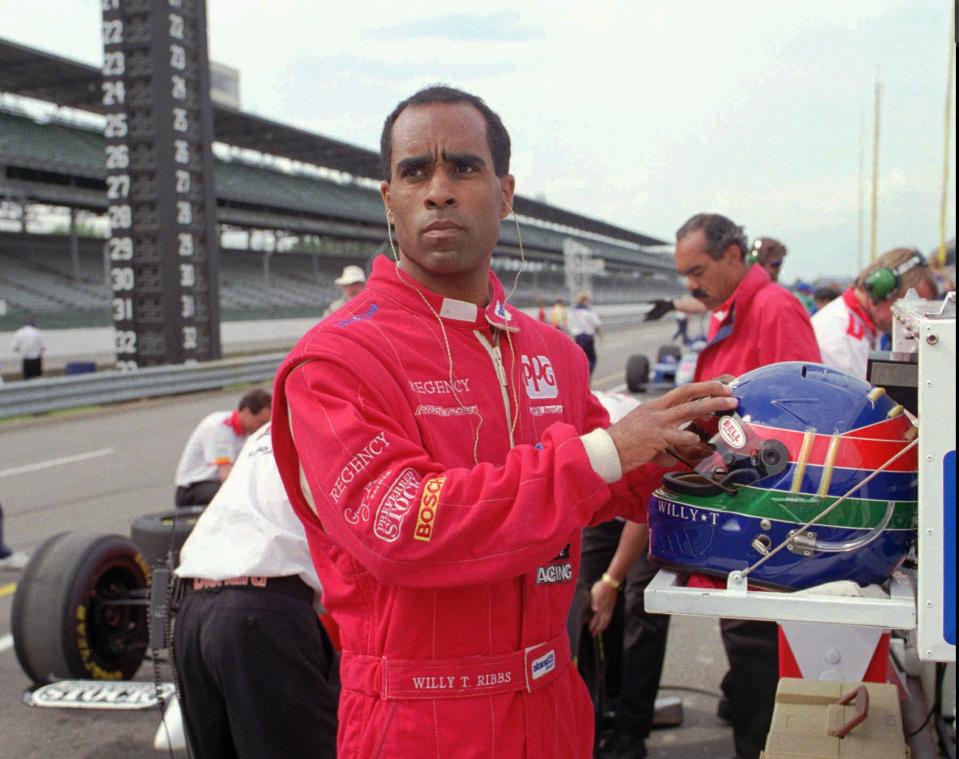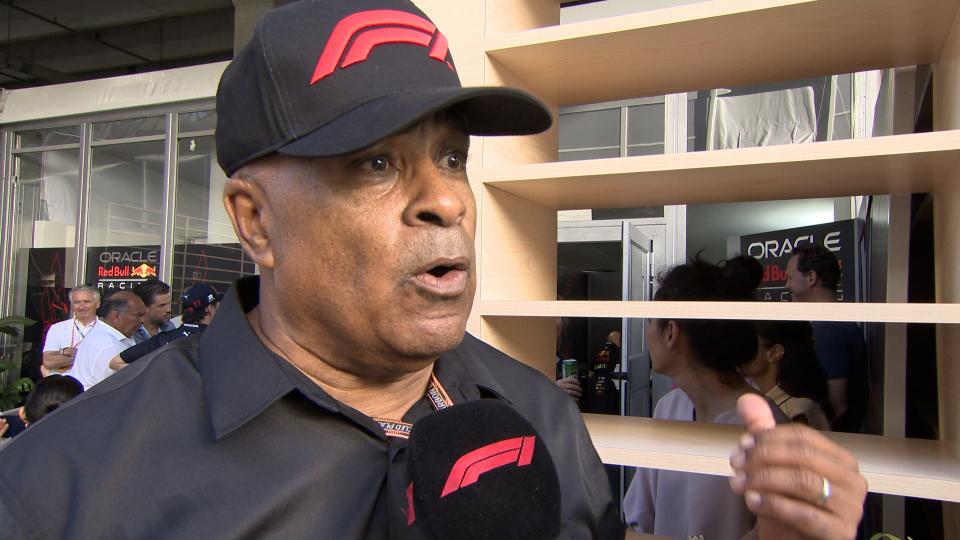Why is F1 second to none when it comes to inclusivity? Allow 'Mr. Diversity' to explain.
Willy T. Ribbs sat in a cozy room in front of a trophy case and racing memorabilia.
He was at his home in Driftwood, Texas, wearing dark aviator sunglasses and a black cap with the red Formula 1 logo on it.
It's been a long time since he drove under that logo, but the legacy he began in the 1970s continues today.
Ribbs, a native of San Jose, California, was the first Black man to race in the Indy 500 and test a Formula 1 car. He endured racial slurs and tension from fans and his own mechanics en route to his trail blazing motorsports career.
Reaching a high level of success was more difficult for Ribbs because the sport requires sponsorship money and − as a Black man competing in the '70s and '80s − there was little opportunity.
Now, at 68, he's a diversity and inclusion representative for Formula 1 and is continuing the work he started decades ago. This weekend, he'll attend the United States Grand Prix in nearby Austin, Texas.
"I was Mr. Diversity before there was a title ‘Diversity in Motorsports,'" Ribbs told USA TODAY Sports during an exclusive interview.
"I was the winning driver at that time. Roger Penske, none of the big team owners called Willy T. Ribbs and said, 'Hey, you should be driving for me.'"

Becoming Mr. Diversity
After the racial reckoning following the murder of George Floyd at the hands of police and other racially-charged acts of violence in 2020, F1 called Ribbs. The organization asked him about taking on the role as they seek to make the sport more inclusive.
"I said, ‘Alright, now you know who you’re hiring, right?’" he recalled. "They said, ‘Yeah, we know who we’re hiring.’"
Ribbs made history with zero tolerance for disrespect and bigotry, and was known for his colorful character. His documentary is called "Uppity," a term he said people used to call him and he "loved it." Newspapers labeled him "flamboyant" for the way he celebrated on top of his car with the signature shuffle of his friend Muhammad Ali after winning races — he won a lot.
He also wasn't afraid to throw a punch when confronted with opposition. And in his career, there was a lot. He was spat at and received death threats. He and his cousin would read hate mail from people who didn't want him racing, and they would laugh at how nothing in the letters was spelled right except for the N-word.
But nothing deterred him because racing was Ribbs' entire life. He picked up a love for the sport from his father, who used to race motorcycles and touring cars in amateur competitions, and was inspired by drivers Jim Clark, Juan Manuel Fangio and Dan Gurney. In the late 1970s, Ribbs opted not to go to college and instead went to England, where he drove in the Formula Ford series and won races against future F1 and IndyCar champion Nigel Mansell.

This year marks the 30th anniversary of the 1993 Indy 500, where Ribbs became the first Black man to finish the esteemed race and placed 21st. Two years earlier, he was the first Black man to race in the Indy 500 after a down-to-the-wire qualifying session, but was forced to retire early due to mechanical failure.
"I had no emotions about (making history)," Ribbs said, looking back on his racing days through his sunglasses. "At that time, when I was younger, it was all about doing well. It was all about performing and trying to get to the finish line first. I had no distractions and emotions in regards to anything else. … That’s not what mattered. What mattered to me was winning. History is for the historians.
"The way I think of it now is, ‘Wow, that was a tough, but fun ride.’ Because I had a lot of obstacles to deal with. I dealt with a lot of resentment and the industry was rough at times on me, but I was rough on them too. And they knew that I wasn’t gonna turn the other cheek. They knew that I wasn’t going to be pigeon-holed or swept under the carpet."
The Great Dan Gurney had personality, so did his drivers 😎 @F1 @SkySportsF1 @jgurney36 @marshallpruett #Ambassador pic.twitter.com/fsEOVmRDkf
— Willy T. Ribbs (@WillyRibbs) September 5, 2023
Willy T. Ribbs celebrates Lewis Hamilton as 'king of diversity'
Ribbs saluted Lewis Hamilton, the only Black driver on the current F1 grid, as "the king of diversity, no question about it," saying "he’s taken the sport to continents on this planet that have never paid attention to Formula 1."
Hamilton, who's won the USGP five times, including Austin's inaugural race in 2012, has made history with seven F1 championships, tied for the most ever. Beside his success on the track, he's helped expand F1 beyond gearheads and transcends into the pop culture lexicon with his involvement in fashion, music and more. He regularly turns heads with his race day looks, has collaborated with Tommy Hilfiger on four clothing collections and is a frequent guest at fashion shows and the Met Gala. He also was a featured artist on Christina Aguilera's 2018 album "Liberation," famously dated Nicole Scherzinger and took time between races this spring to attend Coachella.
As he's ascended in global popularity, Hamilton uses his platform, which includes 34.9 million Instagram followers, to advocate for social justice. Ahead of races in 2020, he wore T-shirts with the sayings, "Arrest the cops who killed Breonna Taylor" and "We breathe the same air, let's fight the same fight." The British driver has also been vocal about his own experiences with racism, dating back to his karting days as a kid.
“I’ve always wondered: Why me? Why am I the only? Out of all the kids in the school, or all the other young Black kids in Black communities, how is it us that stumbled across it and got into it? And not only got in there, but why am I as good as I am? Why am I wired the way I am?" Hamilton said last year during an interview with Vanity Fair. "And I feel like there’s a much bigger picture.”

Last summer, Hamilton was called a racial slur by three-time F1 champion Nelson Piquet. The Brazilian government fined Piquet nearly $1 million.
Ribbs said he knows Piquet from the early days of his own career and remained in contact as they both raced in IndyCar. He said he was "surprised" by the comments.
"Nelson was one of the drivers that was the friendliest towards me," Ribbs said. "I was surprised that came out of Nelson’s mouth. If it would have been directed towards me, Formula 1 wouldn’t have to sanction him or fine him, or the Brazilian government wouldn’t have had to do that, 'cause I would have kicked his [expletive].
"That’s how I’ve always done it; it’s old school. You want to use that kind of language? Well, pop," he said, punching his fist into his hand, "I’m gonna knock the taste outta your mouth for a while. You’re gonna eat your dinner through a straw. That’s the Willy T. Ribbs way. But I’m shocked that came from Nelson and I do want to talk with him about it when I have a chance and say, 'Hey, that’s not you, man.'"
Willy T. Ribbs explains why F1 is leading the way in diversity
Ribbs told Sky Sports at last year's Miami Grand Prix that no auto racing league or sanctioning body is "doing for diversity what Formula 1 is doing." He then said NASCAR is trying and IndyCar is in "last place," according to the IndyStar.
NASCAR has supported Bubba Wallace, the series' only Black driver, in the face of racial discrimination and in 2020, banned the Confederate flag, a symbol associated with racism. The series founded its Drive for Diversity program in 2004 to encourage minorities and women to become involved in the sport.
As part of the Race For Equality & Change initiative, the Indy ladder system welcomed Force Indy in 2020, which competes in the USF Pro 2000 and Indy NXT series, and focuses on "hiring and developing Black American men and women mechanics, engineers, drivers and other staff." The team is backed by Penske.
Last month as part of Force Indy, 23-year-old Myles Rowe won the USF Pro 2000 series, becoming the first Black driver to win a major American open-wheel racing series.
Ribbs celebrated Rowe's accomplishment on social media, posting a photo of the two of them together on X, formerly known as Twitter.
“CONGRATS USF Pro 2000 CHAMPION MYLES (Front)ROWE,” he wrote. “Proud Of You !!!!”
However, there hasn't been a Black IndyCar driver since George Mack in 2002, who joins Ribbs as the only Black drivers to race the Indy 500.
CONGRATS USF Pro 2000 CHAMPION MYLES (Front)ROWE 🏁🏁
Proud Of You !!!! @F1 @Motorsport @RACERmag pic.twitter.com/7YdhnaehxK— Willy T. Ribbs (@WillyRibbs) September 2, 2023
Ribbs said F1 stands apart because of its new and expanded programs, such as the F1 Academy for women and F1 in Schools to promote STEM education. And in 2020, when the series launched a campaign called #WeRaceAsOne, F1 chairman and chief executive Chase Carey gave $1 million to help launch a foundation that encourages diversity by financing apprenticeships and scholarships.
"They are spending millions of dollars, millions of dollars worldwide to open up the sport to people who might not have an opportunity to be in the sport," Ribbs said.
In 2017, American-based company Liberty Media completed its purchase of Formula 1 and enabled the sport to reach new audiences by allowing the use of social media, which previously was banned for all drivers, and expanding the race calendar.
During 2020, F1 had a 99% increase in engagement across its social media platforms, the most of any professional sport body. Ribbs cited Hamilton's influence and the popularity of the Netflix docuseries "Drive to Survive" as contributing factors to the phenomenon.
Willy T. Ribbs on expansion of F1 to Las Vegas, Africa and beyond
Part of Formula 1's growth has meant increased involvement in the United States. This season, there are three stateside races, the most in the sport's history. In November, F1 returns to Sin City for the inaugural Las Vegas Grand Prix. The others are in Miami, Florida, and this weekend's race in Austin, Texas.
Ribbs made some bold predictions when expressing his excitement for the Las Vegas race, which is promising to be a marquee event.
"Everybody on the planet, all the A-listers worldwide, they’re gonna be in Las Vegas," he said, raising his eyebrows above the aviators. "I expect King Charles to be there, that’s how big a deal it’s gonna be. I expect the President of the United States, Joseph R. Biden, to be there. It’s gonna be that big."
@F1 Ambassador at work..
Kick off to this weekends @f1miami #Mega Show #Stars & Cars pic.twitter.com/YQry8inmtn— Willy T. Ribbs (@WillyRibbs) May 5, 2023
The next logical place for F1 to expand to is Africa. Hamilton has advocated for the series to return to the continent. There hasn't been a race there in 30 years. South Africa has been suggested as the site of the event since its Kyalami Grand Prix Circuit hosted races between 1967 and 1993. F1 was close to inking a deal to return to South Africa as part of the 2024 calendar, but it fell through. Ribbs suggested Nigeria would have the economic strength to host a race and said he sees F1 coming to Africa "within the next 10 years for sure."
Ribbs' vision of where F1 can expand is even further.
"What planet do we want to go to next?"
This article originally appeared on USA TODAY: How F1's unmatched inclusivity offers sport massive opportunity

